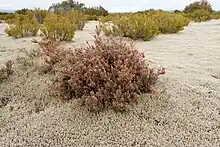| Acrothamnus colensoi | |
|---|---|
 | |
| Scientific classification | |
| Kingdom: | Plantae |
| Clade: | Tracheophytes |
| Clade: | Angiosperms |
| Clade: | Eudicots |
| Clade: | Asterids |
| Order: | Ericales |
| Family: | Ericaceae |
| Genus: | Acrothamnus |
| Species: | A. colensoi |
| Binomial name | |
| Acrothamnus colensoi | |
| Synonyms[2] | |
| |
Acrothamnus colensoi is a species of plant in the family Ericaceae, that is endemic to New Zealand.[3] It is a small shrub that grow to approximately 50 cm tall,[4] and that can spread to form mounds of up to 2 m across.[5] Fruit are round and are white, pink or dark red in colour.[4] It can be found in both the North and South Islands, in scrub, tussock grassland and peat bogs, south of the Kaingaroa Forest.[6]
Description
The species is a low-growing shrub that is sprawling and branched. The leaves are sessile or subsessile and are a glaucescent pinkish green to red-brown. The branches are ascending to erect, weakly ribbed and a grey-brown colour.[3] Its main identifying features are its whiteish, yellow flowers that come in subterminal to terminal racemes and this species also has a fruit / berry. These are glossy and range between white, pink, red crimson and to almost black. The berries are 4–5 mm in diameter, globose, fleshy and are fed on by multiple animal species.[6]

The leaf margins are finely hairy but mostly glabrous and the leaves can have a white stripe on the underside. These leaves are alternate, spreading with greenish veins and white interveinal grooves. The lamina are 5–10 x 1–4 mm and are generally oblong in shape.[7]
Flowers are subtended two keeled bracteoles and a bract which is up to 2.5 mm long and pinkish green to red in colour. These are glaucescent, broadly ovulate, obtuse and ciliolate. The bracteoles are very similar but smaller and distinctly keeled.[6] Its sepals are up to 4 mm long and the imbricate with stomata is only on the adaxial surface. These flowers are seemingly unisexual and between 6–8 mm long with a 4–5 mm long corolla tube and hairy toward lobes.[7]
Taxonomy
A. colensoi was named in honour of William Colenso, a New Zealand missionary, botanist and politician.[6][4]
Distribution and habitat
The Colenso's Mingimingi is a New Zealand native plant, it is an endemic species to New Zealand.[6]It is not a threatened species but it is very difficult to propagate and should not be removed from the wild.[6] It is found in the North and South Islands, generally around and south of the Kaingaroa Plain.[6]
This species habitat is montane to alpine and extends all the way to lower altitudes in shrubland, tussock grassland and to peat bogs in the southern part of its range.
Ecology
A. colensoi has a very distinctive chromosome number that is unlike anything seen in other members of the ericoid Styphelieae in New Zealand. The chromosome number is 2n = 146.[6]
Life cycle/Phenology
This species flowers from September to February in New Zealand and it begins fruiting in November and ends in June. A. colensoi is very difficult to propagate and should not be removed from the wild so a lot of information about the seeds is unknown.[6]
Diet and foraging
The kinds of soil the species prefers, preferred levels of soil nutrients, water and environmental conditions is all currently unknown. The berries from this plant are fleshy and eaten by birds, reptiles and invertebrates. The leaves are very rarely eaten, along with the flowers.[6]
References
- ↑ Quinn, Christopher J.; Brown, Elizabeth A.; Heslewood, Margaret M.; Crayn, Darren M. (2005). "Generic concepts in Styphelieae (Ericaceae): the Cyathodes group". Australian Systematic Botany. 18 (5): 439–454. doi:10.1071/SB05005. Retrieved 20 May 2016.
- ↑ "Acrothamnus colensoi (Hook.f.) Quinn, 2005". New Zealand Organisms Register. Landcare Research New Zealand. Archived from the original on 16 June 2016. Retrieved 21 May 2016.
- 1 2 "Acrothamnus colensoi (Hook.f.) Quinn". Flora of New Zealand. Landcare Research. Retrieved 20 May 2016.
- 1 2 3 Eagle, Audrey (2008). Eagle's complete trees and shrubs of New Zealand volume two. Wellington: Te Papa Press. p. 550. ISBN 9780909010089.
- ↑ "Acrothamnus colensoi (Colensos Mingimingi)". www.terrain.net.nz. Taranaki Education Resource: Research Analysis and Information Network. Retrieved 21 May 2016.
- 1 2 3 4 5 6 7 8 9 10 de Lange, P. J. "Acrothamnus colensoi". www.nzpcn.org.nz. New Zealand Plant Conservation Network. Retrieved 20 May 2016.
- 1 2 Flora Committee. "Acrothamnus colensoi (Hook.f.) Quinn". NZflora. Retrieved 2023-05-17.
![]() Media related to Acrothamnus colensoi at Wikimedia Commons
Media related to Acrothamnus colensoi at Wikimedia Commons